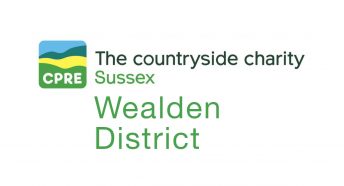Wealden District Update November 2020
CPRE Sussex activity in Wealden District
Wealden Local Plan
Following the withdrawal of the submission local plan in February this year (see the August 2020 update), Wealden has been working on a replacement plan. Their current strategy includes this timetable:
November 2020 Direction of travel consultation
Spring 2022 Draft plan consultation (Regulation 18)
Winter 2022/23 Pre-submission plan consultation (Regulation 19)
Spring/summer 2023 Plan submission and examination
Winter 2023 Plan adoption
The housing numbers currently being considered by Wealden are 1,225 dwellings/year (450/year in the existing plan) and totalling at least 24,500 over a 20-year plan period. There is the possibility that this number may increase as Wealden is duty bound to consider providing houses for neighbouring authorities who are unable to meet their own housing need. It was because Wealden declined to include houses for Eastbourne in their now withdrawn plan that the examining inspector advised that this submission plan be withdrawn as she considered that Wealden had failed in their legal duty to co-operate. The new plan may have to consider including houses to help meet the needs of Eastbourne, Lewes, Tunbridge Wells and Rother.
The current total number of dwellings in Wealden is around 70,000, so even the new plan’s minimum target of 24,500 dwellings represents a massive uplift. With practically no brown field land in Wealden, all the new large developments will be on green field sites which make our surroundings so precious.
We have great difficulty with the term housing need as it is not what most people would consider our need. The natural rate of population change has been negative for many years. Indeed, it is negative across Sussex, with only Brighton showing a positive rate of growth. But the Government has decided that the housing need is to be calculated using the ONS household projections to which an affordability factor is added and designed to increase the supply of housing. Our issue with this approach include the use of the household projections, which are not a forecast but a projection of past trends and that the projections are those from 2014 which have already been superseded by the 2016 and 2018 projections.
In addition, the affordability factor is intended to provide more houses in areas where the factor is high so as to limit the rate of price increase. But it is well known that developers will only build where they can achieve their predetermined price, which is generally set at a level that represents a premium on existing prices, and whenever they cannot achieve this price, they slow down or even stop building until such time as the market will pay the price.
Therefore, the Government’s intention that granting permission to build more houses will result either in a price reduction or stabilisation as a minimum, will simply not come about – it is totally against the developer’s business model.
However, rural Wealden is very attractive to new residents moving from the more expensive areas and this is a trend that is very difficult to manage.
We will continue to use every opportunity to try and ensure the Government desists from its current direction as it is resulting in a large loss of our green spaces together with increased traffic congestion and pressure on our schools, doctors and hospitals. In short, the proposed quantum of new development will have a large impact on residents quality of life, but quality of life is not permitted to be considered when Wealden assess planning applications.
Wealden Local Plan Direction of Travel Consultation
This consultation runs to 18 January 2021 and we urge you to take part. It can be found at: https://www.wealden.gov.uk/planning-and-building-control/planning-policy/wealden-local-plan-direction-of-travel-consultation/
There are 14 sets of questions asking about your thoughts contained in the extensive text. You can answer as few or many of the questions as you see fit. We would recommend that you think what is behind the question before you compose your answer.
The last set of questions in section 14 is interesting. It is about the distribution of new housing and provides four options:
Option 1 – focussed growth at a few settlements
Option 2 – semi dispersed growth to sustainable settlements
Option 3 – dispersed growth with growth at all settlements
Option 4 – new 2,000 – 5,000 house settlements plus further development elsewhere.
Wealden appears to be committed to be planning for the Government’s imposed figure of a minimum of 24,500 dwellings, with potentially many more arising from the Duty to Co-operate. There does not appear to be any recognition of the large areas of the district with environmental constraints or any attempt to seek to try and plan for a reduced number of houses.
Taking the High Weald Area of Outstanding Natural Beauty (HWAONB) as an example, areas within this designation will be unable to accommodate any focussed growth (Option 1) or new settlements (Option 4), and most parts of the HWAONB will be prevented from accepting the Option 2 or Option 3 proposals. Thus, most development will be concentrated in the Low Weald where, as can be seen from the table below, the vast majority of the Planning Committee South permissions this year are located.
If we are to retain our rural surroundings, we cannot accept any of the four proposed options and if you agree, you should make this clear in your response, not just to Q.14, but the other questions as well.
2020 Permissions
This year, the two Wealden planning committees have granted a considerable number of permissions,
| Planning committee | Total | ||
| North | South | ||
| January | 0 | 1,040 | 1,040 |
| February | 85 | 253 | 338 |
| March | 18 | 0 | 18 |
| April | 0 | 10 | 10 |
| May | 1 | 501 | 502 |
| June | 148 | 612 | 760 |
| July | 128 | 205 | 333 |
| August | 3 | 0 | 3 |
| September | 0 | 250 | 250 |
| October | 0 | 0 | 0 |
| November | 29 | 35 | 64 |
| December | ?? | 0 | 0 |
| Total | 412 | 2,906 | 3,318 |
Planning Committee North are meeting in December to consider four applications totalling a further 354 dwellings.
The above figures do not include dwellings granted permission on the smaller sites under delegated powers by officers.
Habitats Regulations
We are concerned that Wealden, in our view, are ignoring the requirements of the Habitats Regulations and so we believe every positive decision notice issued this year is, therefore, unlawful. We think the Council has not correctly considered the effect of the development on two legally protected areas of the Ashdown Forest. We have objected to several applications on these grounds and spoken at planning committee meetings to try and explain the shortcomings to councillors, but so far without success.
A virtual meeting was held with Wealden in October at which we hoped to obtain answers to a list of questions submitted in July with regard to compliance with the Habitats Regulations but disappointingly officers declined to provide the answers.
A Success
There is a small element of good news – officers refused a 70-house application behind the High Street in Ninfield for being outside the development boundary, its adverse landscape impact and its effect on farmland birds. Additionally, an application for 26 houses just outside Crowborough was refused as the site was outside the development boundary. However, we anticipate both refusals will be appealed and that the inspector could well accept both and grant permission.
Nick Daines & John Hurwood for Wealden North & South District Groups



